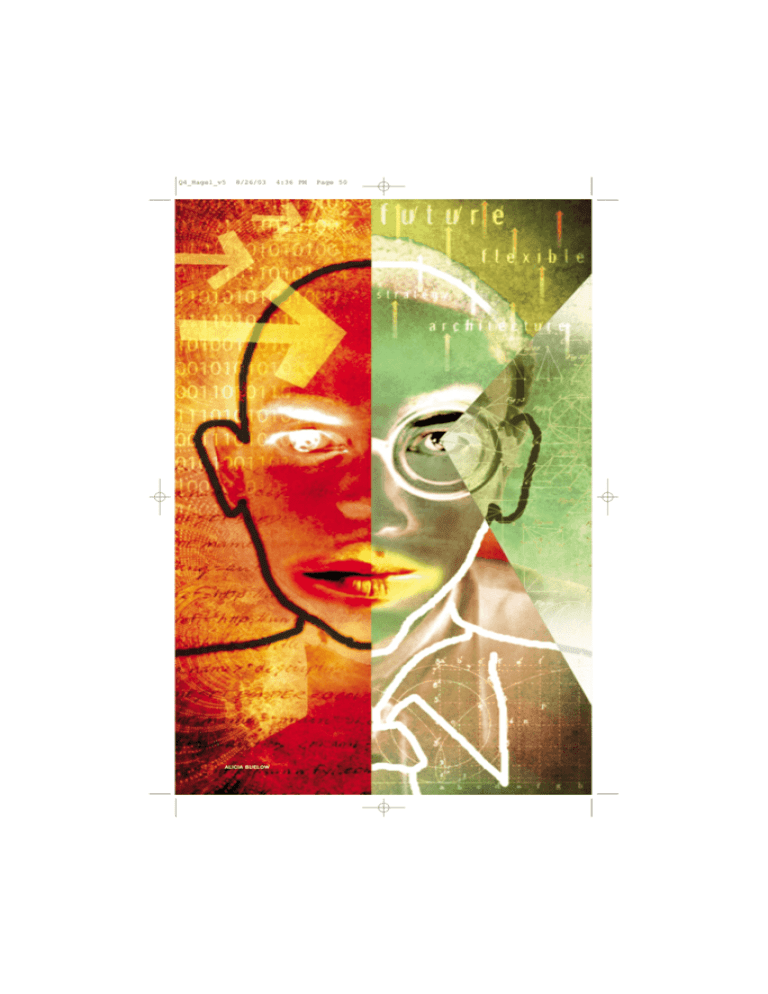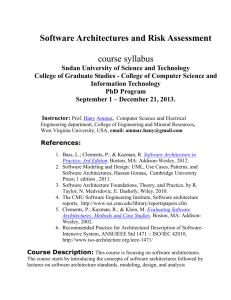
Q4_Hagel_v5
8/26/03
ALICIA BUELOW
4:36 PM
Page 50
Q4_Hagel_v5
8/26/03
4:36 PM
Page 51
51
Flexible IT,
better strategy
John Seely Brown and John Hagel III
IT’s critics say that it lacks strategic importance.
So why does technology keep getting in the way of good strategy?
T
echnology architecture is one subject guaranteed to make a chief
executive’s eyes glaze over. For many CEOs, the topic is mysterious.
Even for those who understand technology better, it is a sore subject because
today’s IT architectures,1 arcane as they may be, are the biggest roadblocks
most companies face when making strategic moves.
Strategists have largely discredited classical notions of strategy formation.
The empty biennial reviews of yesteryear are gone, superseded by “radical
incrementalism,”2 which emphasizes rapid waves of near-term (6- to 12month) operational and organizational initiatives brought into focus by a
shared view of a company’s much longer-term (five- to ten-year) strategic
direction. A quick sequence of focused incremental shifts can produce
1
An IT architecture is the overall structure of and interrelationships among the data, business logic,
and interfaces of a company’s computers and other hardware, applications, databases, operating
systems, and networks.
2
Radical incrementalism is related, but with crucial distinctions, to theories such as strategy by experimentation, the portfolio of initiatives, and time pacing. For radical incrementalism (discussed as “layered strategies”), see Chapter 9 of John Hagel III, Out of the Box: Strategies for Achieving Profits Today
and Growth Tomorrow through Web Services, Boston: Harvard Business School Press, 2002; for strategy by experimentation, see Eric D. Beinhocker and Sarah Kaplan, “Tired of strategic planning?” The
McKinsey Quarterly, 2002 special edition: Risk and resilience, pp. 48–57 (www.mckinseyquarterly
.com/links/7473); for the portfolio of initiatives, see Lowell L. Bryan, “Just-in-time strategy for a turbulent world,” The McKinsey Quarterly, 2002 special edition: Risk and resilience, pp. 16–27 (www
.mckinseyquarterly.com/links/4916); for time pacing, see Kathleen M. Eisenhardt and Shona L. Brown,
“Time pacing: Competing in markets that won’t stand still,” Harvard Business Review, March–April
1998, pp. 59–69. The key distinction between radical incrementalism and these other theories is that
it emphasizes the need for a clear but high-level view of a company’s longer-term (five- to ten-year)
strategic direction to put more near-term initiatives, or “experiments,” into context. Without this longterm context, the near-term initiatives begin to lose coherence.
Q4_Hagel_v5
52
8/26/03
4:36 PM
Page 52
T H E M c K I N S E Y Q U A R T E R LY 2 0 0 3 N UM B E R 4
cumulative and radical change that isn’t easy to copy. Radical incrementalism
has helped companies such as Charles Schwab, Dell, Microsoft, and Wal-Mart
Stores reshape industries and deliver superior returns to shareholders.
Yet radical incrementalism is notoriously difficult to accomplish. Operational
shortcomings and organizational inertia hinder companies from making
near-term innovations in business practice and process. Technology can be
an even bigger hindrance—in part because it’s so deeply embedded in operations and organization, in part because information systems are rigid.
This inflexibility is endemic today. Big suites of enterprise-wide applications
like those in enterprise-resource-planning (ERP) suites, designed to integrate
disparate corporate information systems, dominate client-server architectures. Unfortunately, the onetime, “big-bang,” and tightly defined way in
which these applications have been
implemented, as well as their masThe problems can be so great that sive bodies of difficult-to-modify
some companies abandon new
code, mean that enterprise applicabusiness initiatives rather than face tions integrate businesses only by
changing their enterprise apps
limiting the freedom of executives.
Introducing a new product or service, adding a new channel partner,
or targeting a new customer segment—any of these can present unforeseen
costs, complexities, and delays in a business that runs enterprise applications. The expense and difficulty can be so great that some companies abandon new business initiatives rather than attempt one more change to their
enterprise applications. Far from promoting aggressive near-term business
initiatives, enterprise architectures stand in their way.
The good news is that just as the limitations of the current generation of IT
architectures are becoming painfully apparent, new methods of organizing
technology resources are appearing. IT is on the verge of a shift to a new
generation of “service-oriented” architectures that promise to go a long way
toward reducing if not removing current obstacles to new operational initiatives. These new architectures are no panacea; technology in isolation has
never created strategic value. But service-oriented architectures will enable
companies to introduce new business practices and processes more rapidly
and at lower cost. Such innovations will accumulate by increments into
strategic advantage.
Service-oriented architectures don’t require the removal of existing IT
resources and in fact were developed specifically to help businesses get more
value from them. These architectures (see sidebar, “Getting there from
Q4_Hagel_v5
8/26/03
4:36 PM
Page 53
F L E X I B L E I T, B E T T E R S T R AT E G Y
here”) are still in their early days, but companies such as Eastman Chemical,
General Motors, and Merrill Lynch have already begun to experiment with
them. Companies that follow suit will break free from the constraints of
today’s architectures and become capable of leveraging IT—mostly for the
first time—to gain strategic advantage.
Getting there from here
Service-oriented architectures are in the first
stages of emergence; the current deployment of
Web services technology is a promising early
initiative in this direction. In particular, the foundation standard—the Extensible Markup Language (XML)—provides a major advance by
creating ubiquitous standards for presenting data
and for defining the interfaces that loosely coupled connections require. But other standards
and protocols for service-oriented architectures,
particularly standards and protocols relating to
security and the management of business
processes, will have to become more robust
before they can fully support mission-critical,
long-lived transactions.1 Even for companies
that have started to focus on service-oriented
architectures (such as Eastman Chemical, General Motors, and Merrill Lynch), these additional
emerging standards and protocols remain largely
conceptual. As of now, the use of Web services
technology tends to be very limited in scope and
targeted at a specific area of a business.
However, early implementations are creating
optimism about the business appeal of these
architectures, which can not only provide much
greater flexibility in supporting business operations but also be put into service in a more incremental fashion than previous generations of IT
architectures. Each stage of implementation can
be geared to specific business initiatives and,
with relatively modest investments and short lead
times, deliver tangible business value. Serviceoriented architectures thus represent an inflection point shifting enterprises from rigidity to true
flexibility and also leveraging vast resources that
are already in place by exposing them and
making them accessible as services.
Companies don’t need to shift their entire IT
architecture or to remove existing IT resources to
enjoy the business benefits of a service-oriented
architecture; they can begin with a focused effort
to support specific initiatives. At first, relatively
few IT resources will be accessible in a serviceoriented architecture—for the farm-equipment
maker discussed in the body of this article, only
the supply chain applications in the manufacturing plants. But the accessible resources will be
those most relevant to near-term operating initiatives. The business benefits (in this case, the
operating savings from direct customer access to
order-status data and the revenue benefits from
more satisfied customers) will help finance this
first stage of the transition. Over time, the design
principles of service-oriented architectures will
lead to the development of entirely new services.
1
For more about the emerging standards, protocols, and services needed for mission-critical
transactions, see John Hagel III and John Seely
Brown, “Service grids: The missing layer in Web
services,” Release 1.0, December 2002, Volume
20, Number 11, pp. 1–33.
53
Q4_Hagel_v5
8/26/03
4:36 PM
Page 54
T H E M c K I N S E Y Q U A R T E R LY 2 0 0 3 N UM B E R 4
54
The agony of customized connections
How are today’s IT architectures an obstacle to more agile strategies? Let’s
consider the example of a company that produces and sells farm machinery.
Senior management has looked ahead five to ten years and decided that the
best way for the company to continue creating value would be to evolve into
a customer relationship business, thus deepening its ties with a clientele of
large agribusinesses and serving a broader range of needs.
What can the company do during the next 6 to 12 months to accelerate
this change in direction? Suppose it decides to focus on two initiatives. The
first is intended to provide customers with better, more easily
obtained information about the status of their orders—both
to improve customer service and to reduce operating
costs—since the company maintains a large orderprocessing staff to answer time-consuming customer
inquiries. The second initiative aims to expand the
company’s range of products by allowing it to source
and then resell some complementary ones from thirdparty manufacturers.
On the face of it, neither initiative seems particularly daunting. Let us say,
however, that the company manufactures its products at three US plants, two
of them acquired from other companies. Since different companies owned
the facilities, each of them uses different enterprise applications to run its
operations. Employees checking on the status of orders therefore have to
access three separate applications with very different user interfaces and
ways of presenting product information. This problem explains why the
order-entry staff spends so much time fielding queries.
What would be needed to make the information directly accessible to the
purchasing systems of customers? For each of them, the company would
have to create three custom-designed connections linking the customer’s
purchasing system with the enterprise suites of the three manufacturing
plants—connections that would have to translate information for product
descriptions, shipping instructions and status, and other key data.3 The
custom connections should also provide for adequate security, transaction
monitoring, and message routing. Even if these needs were ignored, the connections would demand a deep understanding of the applications at either
end and of the features specific to them. The connections would be not only
3
Electronic-data-interchange (EDI) systems, which preceded service-oriented architectures, permit
companies to exchange information in standardized forms, thereby avoiding the need for custom
connections. But EDI, focusing mostly on order and shipping information, has very limited application. And while EDI makes it possible to exchange data, custom connections are still required to
translate the information for the applications that use it.
Q4_Hagel_v5
8/26/03
4:36 PM
Page 55
F L E X I B L E I T, B E T T E R S T R AT E G Y
expensive to create (because of the coding time required) but also unlikely
to be reusable for anything other than their original purpose. Technologists
aptly describe custom-designed connections as “hardwired,” because they
lack flexibility.
As for the second initiative, if the company wanted to resell third-party
manufacturers’ products and to give customers for them the same level of
order-status information, it would need to create custom-designed connections between each customer and every supply chain application that its
suppliers happened to run.
Even during the early deployment of the company’s first initiative, its complexity, cost, and lead times would mount. If the company later wanted to
enhance each of these connections—by giving customers a limited ability to
modify orders before they were shipped, for example—that feature would
have to be coded into every customized connection. Suppose too that some
of the company’s first product suppliers didn’t work out and had to be
replaced. It would then have to create entirely new connections. The more
business conditions changed, the greater the complexity, the cost, and the
lead times.
Under today’s information architectures, if you need to connect two
applications, databases, or operating systems—or to connect any of these
to human beings—each connection must be specially created for its specific
purpose, and even the smallest modification requires it to be recoded. Worse
yet, the expense and effort needed to establish connections across technology resources increase exponentially—not linearly—with the number of
resources connected.4 Small wonder that companies spend large portions of
their IT budgets on integration as they create new connections and redesign
old ones to keep up with changing business conditions.
Creating new kinds of connections
Service-oriented architectures take a different approach to connecting
technology resources. Instead of customized, hardwired connections, these
architectures rely on “loosely coupled” ones in which IT resources, even
if they use incompatible operating systems or different vocabularies in their
own operations, can be joined together easily without friction or customization and just as easily disassembled and reassembled. (Of course, this assumes
that all participants have agreed on a standardized vocabulary to serve as a
common translation overlay.)
4
This is the infamous “n-squared” problem, which rears its head as companies add participants to a
network. See John Hagel III, Out of the Box: Strategies for Achieving Profits Today and Growth Tomorrow
through Web Services, Boston: Harvard Business School Press, 2002.
55
Q4_Hagel_v5
8/26/03
4:36 PM
Page 56
T H E M c K I N S E Y Q U A R T E R LY 2 0 0 3 N UM B E R 4
56
All of the information required (for instance, which outputs the software can
deliver, how they are accessed, and who is authorized to do so) is described
and contained in the interface—the electronic description that other applications use to find out how to establish an electronic connection. At the farmmachinery company, the interface to the manufacturing application might
specify that it could provide information on a product’s manufacturing status
and indicate what protocols and standards the “service’s” user (another piece
of software) would need to access the information.5
Of course, the information must be presented in a way that is broadly understandable, and this is the key role that standards and protocols play in supporting loosely coupled connections. Unless the standards and protocols are
widely adopted, the range of feasible connections is very limited. The rapid
spread of the Extensible Markup Language (XML) as a foundation standard,
and the whole series of standards and protocols derived from it, provide an
effective framework for broadly understandable and accessible interfaces.
Much more flexible connections can be established once the standards and
protocols are in place. Since computers can “read” and understand them,
connections can be automatically created as the need arises. The connection
focuses on the service’s output rather than on the details of how it is generated. Thus, connections can be established much more quickly, without
requiring a deep understanding of the underlying features at each end of
the connection.
In effect, service-oriented architectures embody a modular approach to organizing IT resources. As with all such approaches, the key requirements are
standardized definitions of interfaces so that different technology resources
become self-describing, which allows them to be mixed and matched quickly
and easily to meet the requirements of the moment. As new operational initiatives are launched, appropriate applications and information resources are
accessed dynamically to support those changes.
The business benefits
To understand the full benefits of service-oriented architectures, let’s turn
again to the farm-machinery manufacturer. How would such an architecture
help it achieve the near-term operating flexibility required for radical incrementalism and other new approaches to strategy?
The architecture would expose, or make visible to other applications, the
features and capabilities of each of the company’s supply-chain-management
5
Services are created when an application’s features—for example, calculating a currency’s value in
terms of another currency—are “exposed,” or made visible. This visibility is generated through an
interface that describes what data, features, or both are available in the application and how to
access it.
Q4_Hagel_v5
8/26/03
4:36 PM
Page 57
F L E X I B L E I T, B E T T E R S T R AT E G Y
applications. The company’s IT department would accomplish this by creating a standardized interface allowing, say, an order’s status to be available as
a service that could be shared by any application using the same standards
and protocols.
Access would come through a loosely coupled connection established only
“on the fly” when needed, because all of the necessary information would
already exist in the service interfaces. If the consuming
application (in this case, the customer’s procurement
software) didn’t already know which manufacturing
plant to query for an order’s status, a directory service could help identify the appropriate services.
A variety of enabling services of this kind could be
delivered as loosely coupled services shared across
all connections rather than designed into each of
them in advance.
The advantages are significant. Traditional approaches require
programmers to design a customized new connection in advance for each
pair of resources that might need to interact. A service-oriented architecture
requires only a onetime investment to write code that allows the service to
be accessed by any application with an interface adhering to the same widely
available standards and protocols, such as XML and the Web Services
Description Language (WSDL).6 In contrast to hardwired connections,
which have less reusable code (so that each new connection represents a
substantial programming effort), the initial investment in a service-oriented
architecture is amortized further each time a new connection is created.
With services designed to be context free—designed for use by any application or in any business-application environment—companies can more
quickly mobilize services that are already available and deploy them in new
business contexts. In this way, those companies will enhance their ability to
create and test new products, to redesign business processes, and even to
implement new business models rapidly, because they will have less concern
about the potential disruption of their ongoing business activities.
Let’s say that the farm-machinery company wants to streamline its manufacturing operations in one plant and to modify the manufacturing application used there. In architectures dominated by enterprise applications, every
custom-designed connection between that manufacturing application and
each customer would need to be retested and possibly reconfigured because
the proper functioning of the connections depends on assumptions about
how information is generated. With loosely coupled connections, which
6
For more about Web services terminology, see Samir Patil and Suneel Saigal, “When computers learn
to talk: A Web services primer” (www.mckinseyquarterly.com/links/7475).
57
Q4_Hagel_v5
8/26/03
4:36 PM
Page 58
T H E M c K I N S E Y Q U A R T E R LY 2 0 0 3 N UM B E R 4
58
don’t require such assumptions, the company can try out a new business
process in one of its plants without worrying about unanticipated malfunctions in the plant’s customer IT systems.
Service-oriented architectures thus make it possible to create more flexible
connections across applications, and this is probably how such architectures
will first deliver value to the companies using them. But that is only the
Service-oriented architectures will beginning. As more functionality
become the foundation for loosely becomes exposed in the architeccoupled business processes
tures, companies will use this functionality to orchestrate business
processes in a much more sophisticated way: the architectures will become the foundation for loosely coupled
business processes delivering even more flexibility.7
Consider again the farm-machinery company. At present, to fulfill an order,
specific parties must undertake different tasks in a specific sequence, and
any change to it or to the parties means that the order-fulfillment application
must be modified. With a service-oriented architecture, both the sequence
and the parties can be specified at the time of the order. If, for example, the
customer needs financing from a particular institution and wants to have the
machinery shipped before the financial arrangements are fully confirmed—
an exception to standard procedures and thus something the application’s
original programmers hadn’t anticipated—the company can reconfigure its
business processes to meet these exceptional needs.
Much as companies have become familiar with modular product design,
they will use service-oriented architectures to implement modular business
processes. Such processes will make it possible for companies to mix and
match tasks and for resource providers to facilitate both process innovation
and responsiveness to changing markets on the fly. The early focus on creating more flexible connections will inevitably lead to fundamentally different
business processes.
Beyond the firewall
Loose coupling also supports business innovation beyond the boundaries
of individual enterprises: this approach can, for example, be very helpful in
automating connections with business partners, thus making it easier for a
company to add value for its customers by accessing resources that its business partners own. Loose coupling will also accelerate a more fundamental
7
See John Seely Brown, Scott Durchslag, and John Hagel III, “Loosening up: How process networks
unlock the power of specialization,” The McKinsey Quarterly, 2002 special edition: Risk and resilience,
pp. 58–69 (www.mckinseyquarterly.com/links/7477).
Q4_Hagel_v5
8/26/03
4:36 PM
Page 59
F L E X I B L E I T, B E T T E R S T R AT E G Y
unbundling of the enterprise, allowing companies to focus more tightly on
activities in which they are distinctive and to rebundle other assets and capabilities from a broader range of partners. The farm-machinery manufacturer,
for instance, could use service-oriented architectures to move more quickly
to its goal of focusing on its core strength: customer relationships. Since the
company’s automated connections will give it the ability to communicate
with contract manufacturers in a more visible and coordinated way, it can
off-load more and more of its product-manufacturing activities to specialized
companies.
Furthermore, service-oriented architectures automatically generate rich
information about the performance of the connections and the outputs at
each end, simply as a by-product of managing connections. By contrast, capturing such information from manual connections is time-consuming, error
prone, and costly. Automation gives business decision makers much better
information about the overall performance of both IT and the business and
helps them root out inefficiency. Our farm-machinery manufacturer, for
instance, would automatically generate detailed information about customer
inquiries into the status of orders. The company could then improve customer service by systematically cataloging the information and using it as
the basis of proactive order-status reports for certain types of customers and
orders.
The power of emerging service-oriented architectures is hard to ignore. They
make it easier to implement radical near-term changes to business practices
at the local level—changes that can lead over time to radical changes in overall business practices and business structures. That is the essence of radical
incrementalism, and of good strategy.
John Seely Brown, the former head of Xerox’s Palo Alto Research Center and chief scientist at
Xerox, can be reached at jsb@parcxerox.com; John Hagel, an alumnus of McKinsey’s Silicon Valley
office, is now an independent business consultant and can be reached at www.johnhagel.com.
Copyright © 2003 McKinsey & Company. All rights reserved.
59










